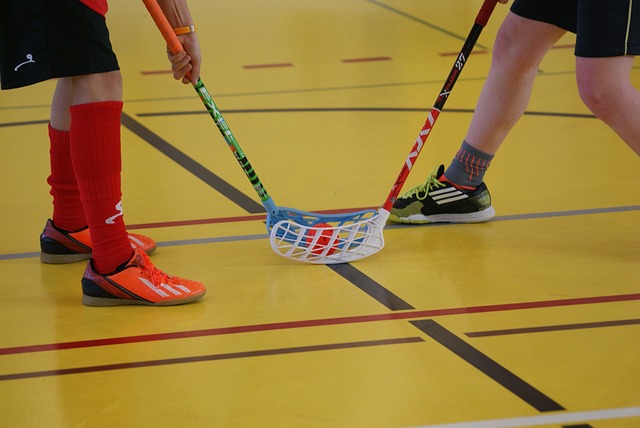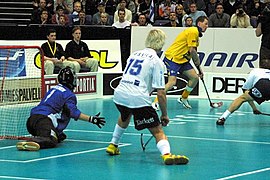Another Introduction to Floorball
One might think I’m overdoing it, by adding yet another floorball post, but I do so for a couple of (what I consider to be) very good reasons:

- First, I don’t want that game to be far from the minds of people who might still be looking for a great way to improved their players’ hockey skills (and maybe even their thinking) over the coming summer months.
- Secondly, seeing myself as a first and foremost “teaching coaching”, I’ve always believed that one can never do too much explaining or simplifying of something new.
Okay, by now I’m hoping you’re seeing floorball as a pretty fast-paced and exciting team sport that has grown in popularity around the world. It’s played with a lightweight plastic ball (much like a Wiffle ball) and sticks, and involves two teams of six players each.
Sticks are made of lightweight materials such as fiberglass, carbon fiber, or wood, and come in a variety of lengths, depending on a player’s height. The ball is made of plastic and is designed to be easy to handle and control.
Beginners looking to learn this sport should find the following useful in understanding this game’s basics…
To start — and not much unlike ice hockey, the objective of the game is for each team to score as many goals as possible by shooting the ball into the opposing team’s goal. The team with the most goals at the end of the game wins.

Floorball can be played on a variety of surfaces, including in gymnasiums, in sports halls, and even outdoors on tarmac or on concrete. An official playing area is rectangular in shape, with a length of 20 meters and a width of 10 meters. The goal area is marked as a semi-circle, with a radius of 1.5 meters.
Each team is comprised of six players, including a goalkeeper, two defenders, two midfielders, and one forward. The goalkeeper is the only player who is allowed to use the hands and feet to stop the ball, while the other players can only use their sticks to pass, dribble, and shoot the ball.
When players are first starting out, it’s important to focus on developing basic skills — such as passing, dribbling, and shooting. Additionally, players should also work on their fitness and endurance, since floorball is a fast-paced and physically demanding sport.
Coaches and parents can help young players improve their skills by providing plenty of opportunities for practice and by emphasizing the importance of teamwork and communication on the court. Incorporating drills like passing and shooting into practice sessions can also be a helpful way to improve skills and game play.
Floorball is a game with constant action, and players need to be at their physical best at all times to play well. To ensure this, substitutions are an essential part of the game. At any point in the game, a team can substitute one or more players. The substitution may happen due to various reasons, like fatigue, injury, or due to tactical decisions.
With that, there are two types of substitutions in floorball…

- In standard substitutions, players must come on and off the court through the designated substitution area at the team’s bench. The player entering the court must wait for the teammate they’re replacing to fully leave the court before stepping on.
- In flying substitutions, players can swap positions without leaving the court. As soon as one player is off the field, the substitute can enter the court. This type of substitution comes into play when the coach wants to make a quick tactical shift or counter.
A floorball game generally lasts for three periods of 20 minutes each. The clock runs continuously unless there’s an injury or some issue that causes the timekeeper to stop the clock. There is a 5-minute break between each of the periods. During the game, each team can call a time-out, with that time-out lasting for one minute. A team cannot call for more than two time-outs in a game. Of course, the timekeeping process is essential to ensure a fair and efficient game. Thusly, the timekeeper uses a game clock displaying the length of the period and the time remaining. A penalty clock may also be used.
In conclusion, while floorball may seem complicated at first, beginners can fairly quickly become skilled and successful with time and practice. And by following the above guidelines or basic tips, coaches and parents should be able to help young players learn to love this game.